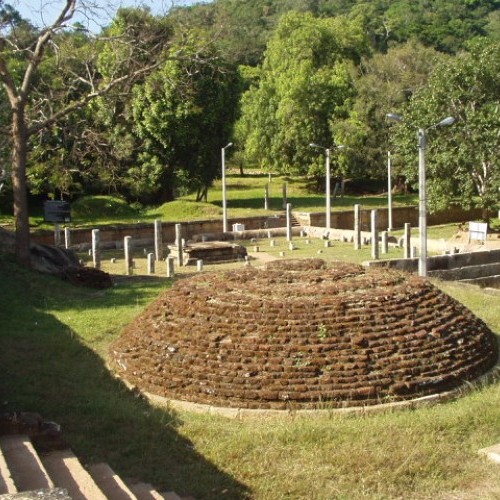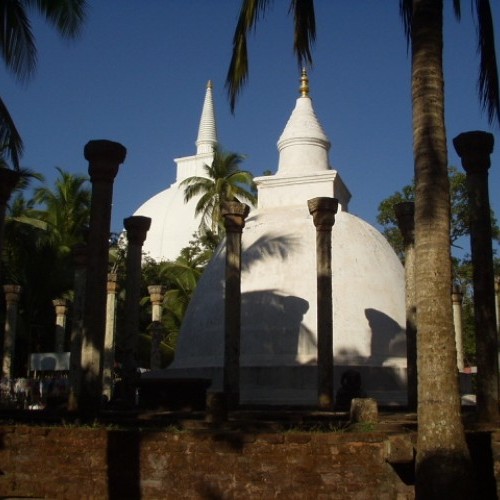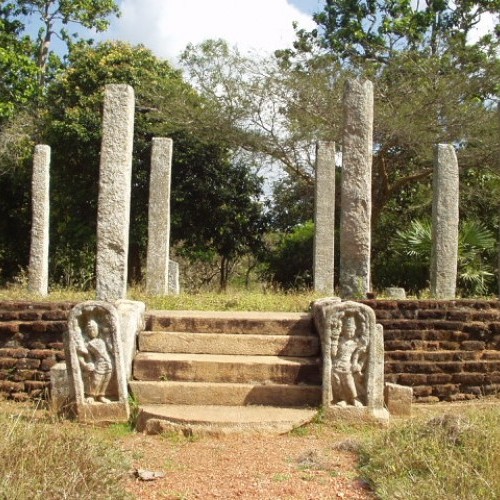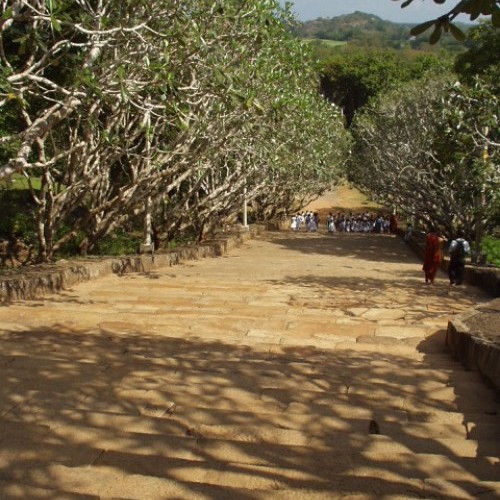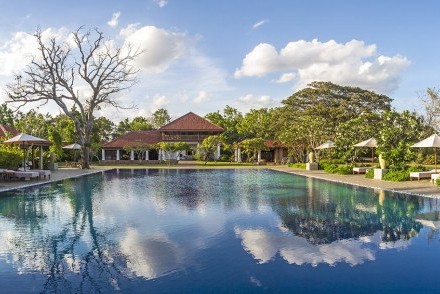Mihintale: Site Details
Cradle of Buddhism
The principal areas of interest at Mihintale include:
- Ancient Medicine
- Kantaka Chetiya
- Off the Beaten Track
- The Ascent
- To the Summit

Ancient Medicine
The Ruins of Vejja Sala
At the foot of the mountain and before the first flight of steps are spread the ruins of a hospital (Vejja Sala), which dates back to the 3rd Century AD, some 400 years before the earliest recorded hospital in Europe. Among the remnants of walls and pillars are monolithic stone troughs for bathing the sick, known as bat oruwa. They are hewn from a single rock, but they have a particularly gripping sculptural quality. The internal cavity is shaped to immerse a recumbent body without wasting precious herbal oils. Stones used for grinding medicinal herbs unearthed here can be seen at the museum, along with medicine jars whose blue glaze indicates that a link must have existed between Persia and the island.
Close by are the remains of the Quincunx, a group of ancient monastic buildings arranged in the form of the five-spot on a six-sided die, which is a characteristic geometric pattern of Anuradhapura.

Kantaka Chetiya
One of the Earliest Religious Monuments on the Island
At the end of the first flight of steps is the 2nd Century BC Kantaka Chetiya, one of the earliest religious monuments on the island, excavated in 1934. The 130-metre base consists of three giant steps of dressed stone, a characteristic of Sinhalese stupas. Above them the dome has worn down to resemble a heap of masonry, reaching 12 m in height. It would originally have been much more impressive at over 30 m high.
The highlights of the building are the four ornamental façades called vahalkadas facing the cardinal points. The eastern façade is the best preserved, with horizontal rows of carvings separated by strips of plain stone. There are beautiful friezes of dwarfs and elephants among the symbolic patterns, and on either side the wall is finished off with a tall carved pillar holding rather weathered lions aloft. The south façade also has some very ornate pillars carved with symbolic animals and plants. There is also a small relief figure of a naga, which is one of the earliest figure sculptures on the island.
South of the ancient stupa is something even older. On a rock shelter that would have been inhabited by Buddhist monks in the 3rd Century BC can be found an inscription in large Brahmi characters, the forerunner to the Pali script. These rock shelters are perched on the edge of a sheer cliff face where the resident monks would sit on narrow ledges and meditate. The Brahmi inscriptions below the drainage ledges bear the names, titles and occupations of the caves' donors. It was considered meritorious to make such hermit dwellings available to the arahants, the holy men, and 68 of them have been found in the Mihintale area.
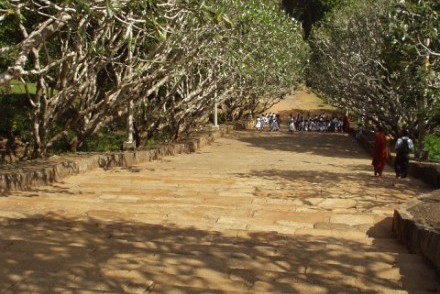
Off The Beaten Track
Ancient Edifices and Tranquil Havens
On a high peak are the ruins of Et Vihara, the "Stupa of the Elephant". It has a panoramic view of the sacred valley on the one side and of Kaludiya Pokuna ("Pond of the Black Water") on the other. This artificial pond at the foot of the western slope of Mihintale served a monastery of the 10th or 11th Centuries. It is a very beautiful and peaceful spot.
Near the base of the westernmost hill is Indikatuseya dagoba ("Stupa of the Needle"). This site caused great excitement among Buddhist scholars when Sanskrit texts belonging to the Mahayana school were found here. They had been transcribed into Sinhala characters and inscribed on copper plaques in the 8th or 9th Century.
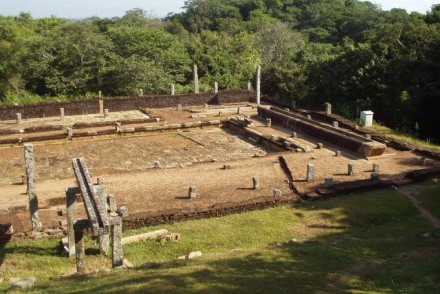
The Ascent
Monastic Remains
The second flight of steps leads to the remains of some monastic edifices. At the entrance of the Dhatu Ghara relic house are the Mihintale Tablets - inscriptions on two stone slabs that formed the rules and regulations that governed the monks. They met to discuss matters of interest at the Sannipata Sala or Assembly Hall and they ate communally at the Bhojana Salava (Monks' Refectory), which is the central courtyard. Beyond it are two huge vats for food hollowed out of single blocks of stone, set at right angles to each other. These are referred to as a bat oruwa ("rice canoe"), on account of its resemblance to a dug-out boat, and a kanda oruwa, a trough containing side dishes, generally curries. They were filled with cooked rice and curries donated to the monks by devout locals. This facility could feed more than a thousand monks.
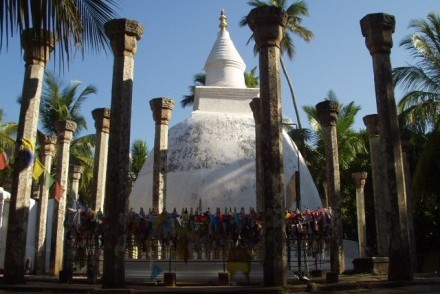
To The Summit
A Spiritual Ascent to the Highest Plateau
The third flight of steps, narrow and steep, takes you on a spiritual ascent to the highest plateau, where the lovely Ambasthala Dagoba marks the place where Mahinda surprised King Tissa in mid-hunt and quizzed him about mango trees to test his intelligence. The Mango Tree stupa is supposedly built on the exact spot where Mahinda stood, and the statue of the King is placed where he stood, a respectful distance away. The great sage Mahinda preached his first sermon from the Aradhana Gala, the "Rock of Convocation", near here.
From this plateau trails spread out in all directions. One leads to the 1st Century BC Mahaseya dagoba, the largest stupa in Mihintale, which enshrines a single hair relic of the Buddha. Another path wends its way to Mihindu Seya where a small golden reliquary resembling the earliest Indian stupas surmounted by a chattra (umbrella) was discovered, along with a bronze statue.
Above them all towers the enormous boulder that covers Mihindu Guha or "Mahinda's Bed". The bed itself is a smooth slab of stone, the covering rock was the roof. This is where the sage reposed, apparently oblivious to discomfort.
Another path leads past a long pool in the shadow of a large low rock which is carved in low relief with a mythical five-headed cobra. This is the Naga Pokuna, the "Cobra Pool". Naga is supposed to be the guardian of treasure, protector of water and the marker of rain. The carving on this natural rock emphasises its association with water and it is said the naga's tail reaches down to the bottom of the pool. The pond is part of an elaborate irrigation network that connects it with Sinha Pokuna, the "Lion Pool", by means of stone channels, which never runs dry even at the height of a tropical drought. The outstanding lion gargoyle spurts water into a handsome square bath surrounded by a wide step carved with a frieze.

